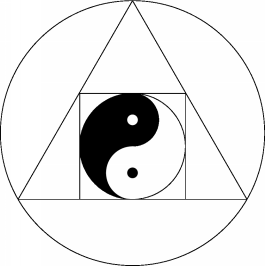7.3 Squaring the Circle
In Alchemy, in order to attain wholeness, it is said that one must “square the circle”, which means to unite the dimensions, or to react indifferently and become equally conscious in all directions. This is also called personal individuation. The problem is that dimensions include sharp angles, unlike the circle which smoothly curves to make a whole entity whose parts are indistinguishable, like the isotropic orb we talked about in chapter IV. Squaring the circle, therefore, means to make the infinite equals the finite, exactly; without extra spaces or any approximation.
As translated by Dennis Hauck, in the Emerald Tablet of Hermes Trismegistus, we read: “That which is Below corresponds to that which is Above, and that which is Above corresponds to that which is Below, to accomplish the miracle of the One Thing.” However, as we argued in section 1.3 above, according to many Islamic sources, Hermes Trismegistus is Prophet Idris or Enoch, whom, by no coincidence in chapter 360 of the Meccan Revelations, Ibn al-Arabi quotes him as saying: “the world exists between the circumference and the point” [I.154.22], which is equivalent to the above translation from the Emerald Tablet. We have demonstrated the cosmological meaning of this statement in Figure 4.1 in chapter V, but in Alchemy this is usually depicted symbolically by a large circle encompassing a triangle that also encompasses a square that is flanked with a smaller circle containing the masculine and feminine, as demonstrated in Figure 7.3. The large circle represents the heavens or the Universe, while the triangle represents the spirit world, or the collective consciousness of everything in equal balance with the Universe. The square represents the physical world with its four corners that represent the four elements.

Figure 7.3: Squaring the circle in Alchemy is usually depicted by a large circle encompassing a triangle that also encompasses a square that is flanked with a smaller circle containing the masculine and feminine. The large circle represents the heavens or the Universe, while the triangle represents the spiritual world, or the collective consciousness of everything in equal balance with the Universe. The square represents the physical world with its four corners that represent the four classical elements.
This is in many ways similar to what we have explained before that the “point” refers to the self-existent Real, Who is the only “true” existence, while the “circumference” is the circle of creations, or the “possible”, contingent entities, whose existence is depending on the Real, all the time, and beyond the circumference is non-existence, or the “impossible”. These three levels of existence, represented in the three points of the equilateral triangle in Figure 7.3, are the two extremes states of vacuum and void, and the multiplicity of the world are various spatial and temporal superpositions between these two primordial states, as we explained previously.
In fact, even the peculiar name “the healer of injuries” that Ibn al-Arabi often employs to refer Hermes Trismegistus, is full of relevant facts and symbols, not the least because he was the originator of most sciences including medicine and Alchemy which is all about healing the body and the soul, as well as balancing the elements. Additionally, since Alchemy is deeply related to Numerology, if we calculate the numerical value for this Arabic name “Mudawi al-Kulum”, by taking only its unique letters (mim=40, dal=4, alif=1, waw=6, yaa=10, kaf=20, lam-30) we get 111, which is the same as the numerical value for the Arabic word for Pole (qtb=111: qaf=90, tta=9, baa=2), and the three ones here represent the equilateral triangle in Figure 7.3 and the very fact behind his title “Trismegistus”. Furthermore, the first word of this Arabic name has the same root of the word (duwat) which means the “inkwell” while the second word is also intimately connected to (kalam, kalimat) which means “words” and writing, which is all connected with the fact that he was the first to use the pen and invent writing. As we will see further in section 2.5, Alchemy, as well as cosmology, according to the Sufis, are connected with Numerology. The ultimate reason behind this mysterious relation is the fundamental nature of complex-time geometry, which is the recurrence of one Single Monad, which is the essence of geometry and number theory. For this reason, as Ibn al-Arabi showed, the first secret that was revealed to this Pole of Spirits, is the First Age, from which all other ages are formed [I.152.15].



















